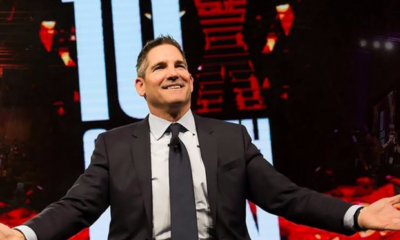Success Advice
How to Make Millions on the Phone – Grant Cardone

Watch Grant Cardone’s “How to Make Millions on the Phone” massively popular video webcast for Addicted2Success.
Everyone is connected on this planet instantaneously through the Internet. Social media sites like Twitter, Facebook, Google+, YouTube and LinkedIn are being used many times a day to catch up on news, find out what you, friends and family, are doing, to get attention, and to market yourself. But there is one device more powerful than all of that combined when it comes to making and closing sales—the phone.
The phone is a more powerful tool than all of these other technologies combined. This is because at some point in everyone’s career they must use the phone to reach the right person, close a critical sale, follow-up with a customer, or to handle a customer inquiry.
The phone is money—and everyone has one. There are almost as many cell phone subscriptions as there are people on the planet! That is 6.8 billion subscriptions in the world, and in the U.S. alone there are just under 1-trillion phone calls per year!
Whether the phone is used for making contacts with customers or making cold calls to get new customers, it is the most powerful business weapon you can master. The phone is necessary and integral to your success. Yet, for many reasons, most people are terrible at using the phone. SalesForce suggests that 92% of all customers use the phone before making a purchase, and 85% claim to be dissatisfied with the interactions.
Like me you may have been made to believe that you couldn’t sell your products over the phone—but, of course, that isn’t true. Being in front of someone is the most effective way, but it is very expensive and can cost as much as 8x more than a call and almost impossible to scale out horizontally because of the time it takes to travel.
Calls are immediate and powerful if you can get the right person on the phone, and know how to use that time effectively.
Here’s my video conversation with Joel Brown from Addicted2Success on how to make millions on the phone.
Here are five proven steps on how to handle the phone calls properly and help you increase your business immediately.
1. Time is the Sale Killer
Spending time with chatter and small talk will kill your chances of closing with a prospect. The old school mentality doesn’t work—you must get in and get out.
You may only have 2 minutes to get an appointment, find an influencer or a decision maker, and find out their needs. Use your time effectively.
2. Your Words Matter
The quickest way to blow a sale is by saying the wrong things—one wrong word is all it takes. You can no longer say things like, “I hope I’m not bothering you…” etc.
Be confident, be polite, and don’t waste time. The words you use will only do one of two things – Bring you closer to a sale or bring you further from one.
3. Voice, Inflection, and Tone
How you say it is far more critical than what you say. There are ways to say things to anyone so that they never forget you or your pitch—they are called hooks and tone control. No matter what you do for a living at some point in your career you will rely on a phone to either introduce yourself or get an appointment.
The phone is the single most important tool—besides your commitment and attitude about success—to build your brand, your company, and your revenues.
4. Production before Perfection
My entire career I have seen sales people get paralyzed by trying to achieve perfection. The most important thing is not to be perfect, the most important thing is to make the call. The muscle of making calls is most difficult part of becoming a master of the phones.
In my office we intentionally give new salespeople very little direction and push them for call volume before anything. I always felt that the skill component of the call is easier to train than the muscle of actually dialling calls.
5. Do the Math
In order to push yourself towards more calls and better conversions, you must do the math. Spend the time to break down how much you make in a month and divide it by the number of dials that you make. It always helped me to know how much each call I was making meant to me, this way, every call was a win regardless of the actual outcome.
I will be going in depth on these points and so much more – really tackling everything that has to do with selling over the phone, incoming calls, prospecting and follow-up. I promise that this will be the best investment you make in yourself this year.
I normally sell access to my webinars for $799 but for the Joel and the followers at Addicted2Success I am offering a special promo price. I promise AT LEAST 3 hours of high value, actionable strategies that will get you more confident before the call, closing at a higher rate, and cashing in on the biggest paychecks of your life – sign up here.
During the Webcast you will learn:
- How to Get Past the Gatekeeper
- How to Use the Phone to Make Millions of Dollars
- How to Separate Yourself from the Competition
- How to Qualify the Buyer Over the Phone
- How to Handle Price on the Phone
- How to Create Urgency
- How to Increase Your Show Rate 500 Percent
- How to Use Price to Fill Up Your Pipeline
- How to Close on the Phone
- What to Never Say on the Phone
- How to Increase Your Close Rater Over 200 Percent
- How to Follow-Up the Unclosed Buyer
Look, it’s amazing how small changes in a few phrases on a phone call will keep a customer from shopping the competition. Or how asking for an appointment with just a slight change in inflection will improve your show rate on appointments by 500%! It was like magic when changing my opening changes the buyer’s immediate impression and how a little urgency could move a buyer from seeing me next week to wanting to see me today.
See you during the webcast -> Join now.
Did You Know
How Skilled Migrants Are Building Successful Careers After Moving Countries
Behind every successful skilled migrant career is a mix of resilience, strategy, and navigating systems built for locals.

Moving to a new country for work is exciting, but it can also be unnerving. Skilled migrants leave behind familiar systems, networks, and support to pursue better job opportunities and a better future for their families. (more…)
Life
10 Research-Backed Steps to Create Real Change This New Year
This New Year could finally be the one where you break old patterns and create real, lasting change.

Every New Year, we make plans and set goals, but often repeat old patterns. (more…)
Change Your Mindset
The Silent Skill That Makes People Respect You Instantly
What truly earns respect and why most people go about it the wrong way

Everybody craves respect but not everyone earns it. Some people believe that a title, years of experience, or a position of authority automatically entitles them to respect. (more…)
Entrepreneurs
The Essential Skills Every Entrepreneur Needs In 2026
Success in the digital age isn’t about luck. It’s about mastering the skills that separate dreamers from doers.

When I was 22 years old, I started my first side hustle as a ghostwriter. (more…)
-

 Business4 weeks ago
Business4 weeks agoWhy Your E-Commerce Fulfilment Is Probably Broken (And How to Fix It)
-

 Shift Your Mindset4 weeks ago
Shift Your Mindset4 weeks ago11 E’s That Define Every Great Leader And Why Most People Miss Them
-

 Did You Know3 weeks ago
Did You Know3 weeks agoThe Success Patterns You Inherited (And Didn’t Notice)
-

 Entrepreneurs2 weeks ago
Entrepreneurs2 weeks agoThe Essential Skills Every Entrepreneur Needs In 2026
-

 Business3 weeks ago
Business3 weeks agoThe Hidden Money Pit in Your Operations (and How to Use It)
-

 Change Your Mindset2 weeks ago
Change Your Mindset2 weeks agoHow to Turn Your Mind Into Your Greatest Asset (Instead of Your Enemy)
-

 Change Your Mindset2 weeks ago
Change Your Mindset2 weeks agoThe Silent Skill That Makes People Respect You Instantly
-

 Life1 week ago
Life1 week ago10 Research-Backed Steps to Create Real Change This New Year



























1 Comment